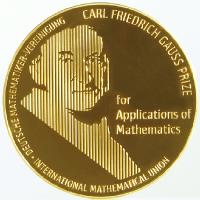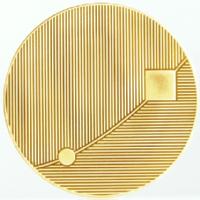Interpretation of the Gauss Prize medal
Soon after Giuseppe Piazzi discovered the celestial body
Ceres on January 1st, 1801, Ceres disappeared from view,
and there were no reliable techniques available to predict
its orbit from Piazzi's limited observational data. Introducing
a revolutionary new idea, the now well-known least squares
method, Carl Friedrich Gauss was able to calculate Ceres'
orbit in a very precise way, and in December 1801 Ceres
was rediscovered by the astronomer Zack very close to the
predicted position.
This impressive example illustrating the power of the
applications of mathematics provided the general idea
for the design of this medal.
Dissolved into a linear pattern, the Gauss effigy is
incomplete. It is the viewer's eye which completes the
barcode of lines and transforms it into the portrait
of Gauss.
A similar pattern, accomplished by horizontal lines, is
one of the features on the back of the medal. This grid is
crossed by a curve. The disk and the square, two elements
connected by the curve, symbolize both the least squares
method and the discovery of Ceres' orbit.
The mathematical language has been reduced to its most
fundamental elements, such as point, line and curve.
Moreover, these elements represent natural processes.
The imagery of the medal is a synthesis of nature's
and mathematics' sign language.
Jan Arnold
|

 Contact
Contact


